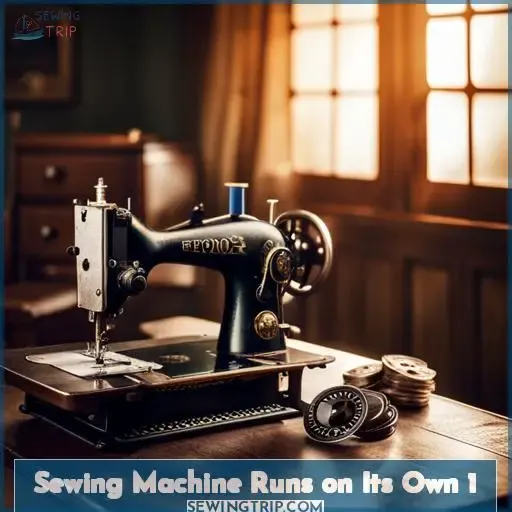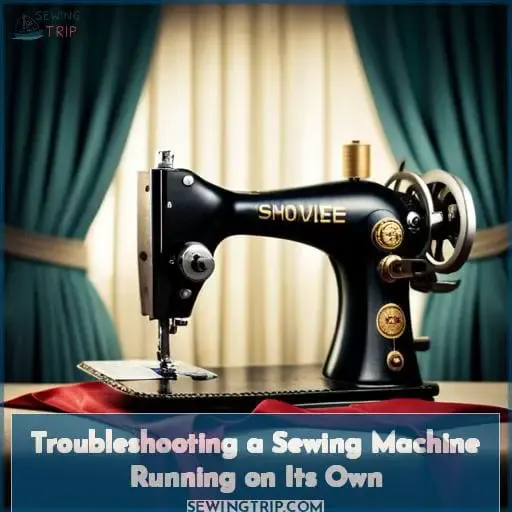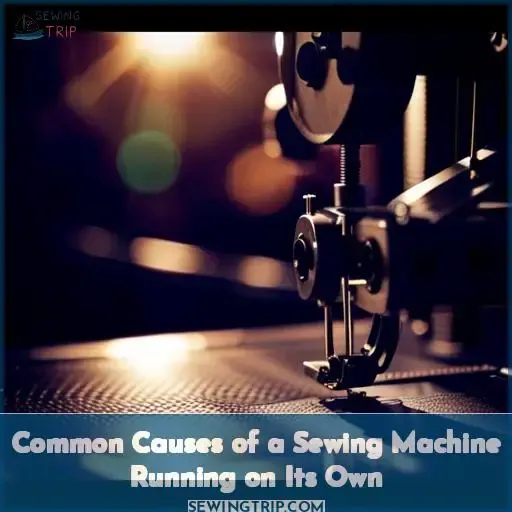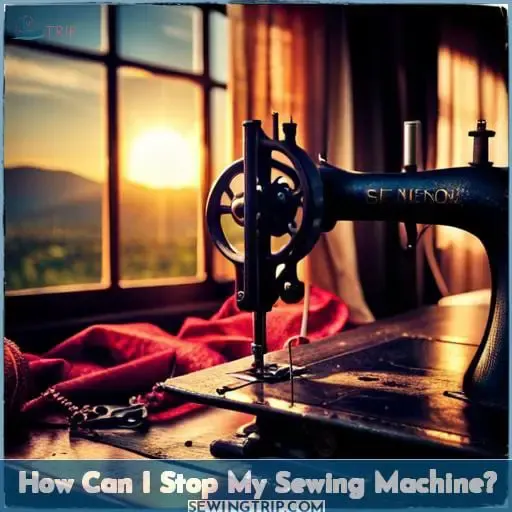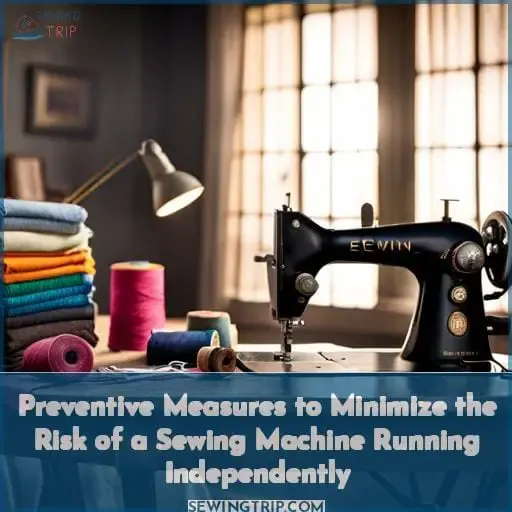This site is supported by our readers. We may earn a commission, at no cost to you, if you purchase through links.
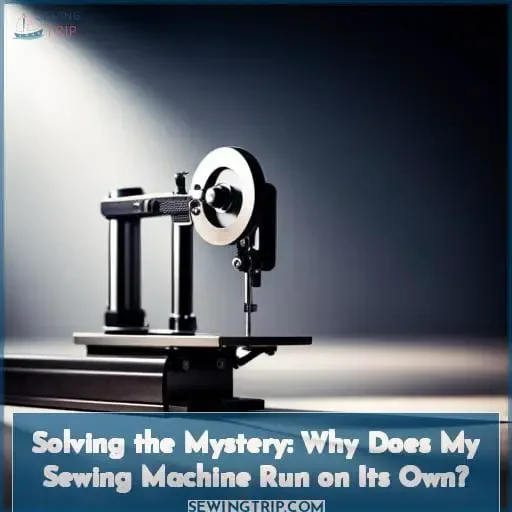 Are you curious if a sewing machine can run on its own? It might sound like something from a science fiction movie, but the truth is that it’s actually quite possible.
Are you curious if a sewing machine can run on its own? It might sound like something from a science fiction movie, but the truth is that it’s actually quite possible.
If your sewing machine starts running without pressing the foot pedal, this could mean there is an issue with the capacitor in your foot pedal or some other malfunctioning component.
In this article, we will explore common causes of when a sewing machine runs independently and discuss troubleshooting tips to help get it back up and running properly again.
Let’s dive into what signs to look for when diagnosing why your beloved companion has decided not to listen anymore!
Table Of Contents
- Key Takeaways
- Signs of a Sewing Machine Running on Its Own
- Troubleshooting a Sewing Machine Running on Its Own
- Common Causes of a Sewing Machine Running on Its Own
- It’s Time to Remove or Replace the Capacitor
- How Can I Stop My Sewing Machine?
- Preventive Measures to Minimize the Risk of a Sewing Machine Running Independently
- Frequently Asked Questions (FAQs)
- Conclusion
Key Takeaways
- Sewing machine running on its own can be caused by issues with the foot pedal, circuit board, tension settings, loose parts, or timing malfunctions.
- Signs of a sewing machine running on its own include sudden start/stop, inconsistent speed, uncontrollable movement, needle breakage, and thread snapping.
- Preventive measures such as regular maintenance, proper handling, and professional servicing can help avoid the machine running autonomously.
- Troubleshooting steps include inspecting the foot pedal, checking connections, examining the circuit board and tension settings, and checking for loose screws/parts.
Signs of a Sewing Machine Running on Its Own
You may notice sudden start and stop, inconsistent speed, uncontrollable movement, needle breakage, or thread snapping if your sewing appliance is running on its own. This can be a result of several issues such as foot pedal malfunction, circuit board malfunction, or tension problem.
It could also be due to loose parts or incorrect timing that lead the machine to run out of control. To prevent this from happening, it is important for you to keep up with regular maintenance checks on your equipment and handle them properly when using them to avoid any potential problems.
A good way of troubleshooting the issue would be by turning off the machine first, then inspecting the foot pedal for any faults. After that, check all connections in regards to both the circuit board and tension settings before finally looking into any loose components within its structure.
Also, make sure that everything is in sync according to their respective timings without fail.
If these steps are taken regularly, then you should have no difficulty maintaining proper use over your sewing device while ensuring minimal risk from independent operation at all times!
Troubleshooting a Sewing Machine Running on Its Own
If you’re experiencing problems with your sewing machine running on its own, it’s important to take some steps in order to diagnose and resolve the issue. First, switch off the appliance; then check if there are any faults with the foot pedal.
Additionally, examine all connections related to both the circuit board and tension settings, and ensure all screws or parts are secure within its structure.
Turn Off the Machine
Turn off the machine immediately to contain any damage and prevent further problems from arising – but don’t you wonder why it started running by itself in the first place? It could be due to tension issues, electrical wiring problems, a malfunctioning foot pedal, or loose parts.
Additionally, timing malfunctions or electrical interference with its power source can also cause this issue.
To avoid such occurrences in the future, regular maintenance should be done on both the machine’s foot pedal as well as its internal electrical work.
Check the Foot Pedal
Carefully inspect the foot pedal, as it could be the culprit behind your sewing device’s sudden independent behavior. Check all connections and adjust any settings that may need tuning up. Replace parts if necessary and clean out dirt or debris from its small silver cylinder with a soft cloth.
Check the Circuit Board
Examine the circuit board to ensure that it is functioning correctly. Check the wiring, replace the capacitor, and adjust the tension as necessary. For older machines, pay special attention to the machine’s foot pedal as this could be the root of the problem.
Make sure all electrical components are up-to-date with modern electrical standards before attempting any adjustments or repairs on your own sewing machine.
Check the Tension
Check the tension settings of your sewing apparatus to ensure that they’re properly adjusted and not causing any issues with its operation.
Threading, needle tension, machine lubrication, and other various factors can all affect a sewing machine’s performance. Adjust the tension accordingly for different speeds or straight lines while also considering stitch quality.
Electrical wiring may be responsible if you experience sudden stops or uncontrollable movement in your device, so make sure to check it too!
Ultimately, proper maintenance is key when dealing with a malfunctioning sewing machine.
Check for Loose Screws or Parts
Inspect your sewing apparatus for any loose screws or parts that could be causing it to malfunction. Check the foot pedal, connectors, and tension settings for signs of wear. Replace parts as necessary and tighten all screws securely.
With older models, check voltage levels and clean connections may resolve electric problems like a strong smell or sparking wires.
Common Causes of a Sewing Machine Running on Its Own
It is important to be aware of the common causes behind a sewing machine running on its own. These can include foot pedal malfunction, circuit board malfunction, tension issues, loose screws or parts, and timing malfunctions.
To ensure your device is working correctly at all times, it is essential to diagnose these potential issues early and take action accordingly.
Foot Pedal Malfunction
If your sewing device is acting up, it could be because of a malfunctioning foot pedal. Take the time to look into it and ensure that everything’s in working order! Troubleshooting the machine’s foot pedal can help you identify electrical problems like capacitor failure.
To resolve this issue, try removing or replacing the capacitor. If there are still no changes, then seek professional guidance.
Here are some quick fixes for basic issues:
- Check connections.
- Tighten screws.
- Test resistance.
Failure to address these problems may result in needle breakage or unexpected stoppages.
Circuit Board Malfunction
You may experience your device going haywire if the circuit board is malfunctioning, like a wild stallion. This can be caused by improper capacitor removal or voltage testing. An unchecked motor issue could also lead to thread jamming and other circuitry-related issues in modern technology.
For best results, consult with an internationally electrotechnical commission certified technician for a more thorough repair job than you could do yourself on a Singer Featherweight machine’s foot pedal.
Regularly clean and inspect all components inside your sewing machine as well. This will help prevent malfunctions from occurring in the future!
Tension Malfunction
When your fabric stitching is off, it could be a sign of tension malfunction in your device. Electrical wiring issues or a damaged capacitor can lead to thread snapping and needle breakage. Inconsistent speed is also common with this type of issue, as well as timing problems on the machine’s foot pedal.
Loose Screws or Parts
Checking for loose screws or parts is essential to ensure your sewing device operates at its best, as almost 30% of machine malfunctions can be attributed to these issues. Loose screws and parts often lead to sudden movement, needle breakage, thread snapping, and inconsistent speed.
Capacitor removal may also be necessary when addressing certain electrical wiring issues related to tension malfunction.
Timing Malfunction
Diagnosing a timing malfunction can be tricky, so it’s important to make sure all components are in perfect sync for your sewing device to operate at its best. Timing accuracy must be checked along with circuit connection, thread tension, and machine alignment.
Pedal calibration is also essential as the cylindrical part of the foot pedal plays an important role in controlling sudden movement of your sewing machine.
Don’t let that happen – ensure optimal performance by regularly checking each component before any project begins!
It’s Time to Remove or Replace the Capacitor
If you’ve identified a capacitor as the source of your sewing machine’s erratic behavior, it’s time to remove or replace it. Depending on your electrical experience and the age of the machine, this can be a difficult task.
If you’re unsure if removing or replacing a capacitor is something that should be done by yourself, consult with an experienced technician.
The lifespan of capacitors varies greatly depending on usage and the environment they are in. So sometimes simply replacing them can solve any issue at hand for older machines. This is why having knowledge about what symptoms are common with capacitor issues will help identify problems quicker than just guessing which part needs to be replaced or removed from the device itself when troubleshooting any problem related to capacitors in sewing machines.
Removing and/or replacing capacitors requires shutting off all power sources before beginning work since electricity still flows through most parts even after being turned off manually due to residual charge stored within some components like these types of parts found inside many electronic devices – such as sewing machines.
With the correct steps followed correctly while handling such sensitive pieces of equipment, suddenly running your own becomes a less daunting task. Tackling one’s DIY capabilities increases the chances of success during the process of solving mysterious malfunctions afflicting your beloved crafty companion.
This brings peace of mind, knowing that its optimal performance levels will be regained as soon as possible, allowing you to complete your project within the desired timeframe originally planned.
How Can I Stop My Sewing Machine?
Now that you understand the common causes of a sewing machine running on its own, it’s time to put your newfound knowledge into action. To stop your modern sewing machines from malfunctioning, there are several steps you can take if you have plenty of electrical experience.
The first step is to reset the pedal; this will help restore normal functionality and prevent further issues with the machine’s operation. Next, inspect any wiring or connections for signs of wear or damage and replace them if necessary.
You should also check for loose screws or parts as these could be causing problems with tension settings and other mechanical components in the device itself.
Finally, make sure all threads are correctly threaded through their respective guides before beginning any work so troubleshooting becomes easier later down the line when something doesn’t seem right during use!
Once these steps have been completed successfully, then it’s time to move onto more advanced maintenance tasks such as replacing capacitors. This may require professional assistance depending on how experienced one is dealing with electronics.
To ensure everything runs properly again after a potential issue has been resolved, always test out each function separately by using different speeds and pressure levels while making adjustments accordingly until desired results return.
Preventive Measures to Minimize the Risk of a Sewing Machine Running Independently
Maintaining a functional sewing machine requires regular maintenance, proper use and handling, and professional servicing. These steps are essential to ensure the device runs optimally and does not malfunction on its own.
To avoid any potential issues with the machine’s performance, it is necessary to take preventive measures such as regularly checking for loose screws or components, ensuring correct tension settings are applied each time it is used, and seeking timely service from an experienced technician when needed.
Regular Maintenance
Regular maintenance is key to keeping your crafty companion in top condition and avoiding unexpected malfunctions. A good first step for those with much electrical experience would be to reset the pedal, check wiring/connections for damage or wear, and inspect screws/parts that may have become loose over time.
Common reasons, such as tension settings not being correct, can also cause most alarming issues when working on complex projects.
The above steps are necessary if one wants their machine running smoothly at all times without any unnecessary surprises resulting from lack of preventative measures taken priorly!
Proper Use and Handling
You should always use and handle the machine properly to minimize malfunctions. A statistic that may help illustrate this is that preventive maintenance can lead to up to 90% fewer breakdowns. Maintaining habits such as adjusting knobs correctly, cleaning components regularly, and repairing parts when needed are key.
Replace any damaged or worn-out components in order for the sewing machine to run smoothly – like a cup of tea! To ensure safety, it’s best not to leave your machines running unattended or try tackling too complex projects without professional assistance if you’re not sure what you’re doing.
Professional Servicing
To keep your creative companion in peak condition, it’s best to have it professionally serviced regularly. This should include a capacitor removal, such as cleaning or replacing the wiring and motor components.
It also involves adjusting timing belts and tension discs, as well as checking for loose screws or parts that could cause damage during operation.
In addition to these maintenance tasks, you’ll want to ensure proper use of the machine before each use.
Regular Maintenance:
- Capacitor Removal
- Adjusting Timing Belts & Tension Discs
- Check Loose Screws/Parts
Proper Use:
- Set Knobs Correctly
- Secure Clamps Needed For Fabric
- Stop Machine Properly
A well-serviced sewing machine will help create beautiful projects with minimal surprises along the way, giving you freedom over your creativity!
Frequently Asked Questions (FAQs)
What should I do if my sewing machine starts to run on its own?
If your sewing machine suddenly starts running on its own, immediately turn it off and check the foot pedal, circuit board, tension settings, screws/parts, and timing.
How do I know if my sewing machine has a capacitor issue?
Discover if your sewing machine has a capacitor issue by inspecting the electrical wiring. Look for signs of wear and heat damage, as these could indicate that the capacitor is not functioning correctly.
Carefully examine any exposed parts to ensure they are in good working order and free from corrosion or debris.
Is there a way to test my sewing machine for any issues?
You can test your sewing machine for any issues by turning it off, inspecting the foot pedal and circuit board, checking the tension, looking for loose parts or screws, verifying the timing is correct, and examining the electrical wiring.
How often should I have my sewing machine serviced?
Regular maintenance and professional servicing are crucial for keeping your sewing machine running smoothly.
Are there any alternatives to prevent a sewing machine from running on its own?
You have the ability to prevent a sewing machine from operating autonomously. Regular maintenance, proper usage and handling, and professional servicing are some alternatives that can assist in reducing the risk.
Conclusion
To keep your sewing machine running smoothly, it’s important to take preventive measures and practice proper use and handling. With regular maintenance, you can be sure to prevent any sudden start or stop issues.
Furthermore, if your machine does begin to act up, you can troubleshoot the problem by following the steps we have mentioned. By being proactive and taking care of your machine, you can avoid any major issues and keep your sewing machine running as it should.
Overall, if you take the time to maintain and troubleshoot your sewing machine, you can enjoy a seamless and enjoyable sewing experience. With the right knowledge and techniques, you’ll be able to keep your sewing machine running in top condition for years to come.

